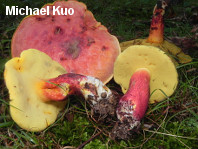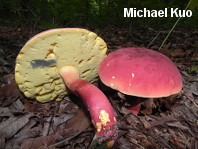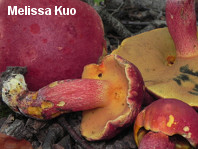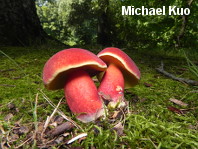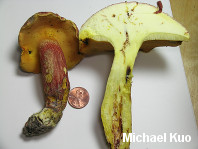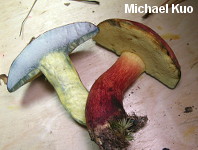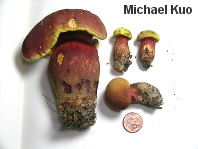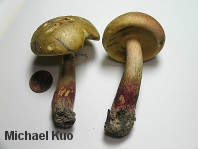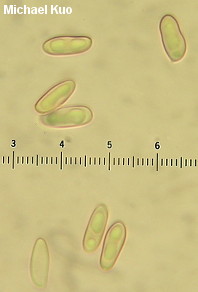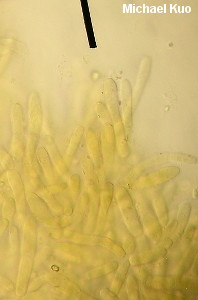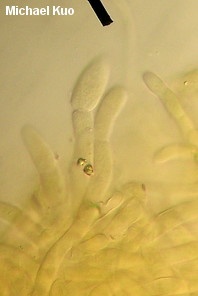| Major Groups > Boletes > Red-Capped, Blue Staining > Boletus carminipes |

|
Boletus bicolor [ Basidiomycota > Boletales > Boletaceae > Boletus . . . ] by Michael Kuo Charles Peck named this species (1872) Boletus bicolor, the "two-colored bolete," because of its beautiful and starkly contrasting red and yellow colors. The cap and stem, when fresh, are bright red, and the young pore surface is bright yellow. The pore surface bruises blue promptly, but the mushroom's other surfaces usually do not--and the sliced flesh, most of the time, turns blue only faintly and erratically. Other crucial identification features include the proportionally shallow depth of the tube layer, and the fact that the stem is red nearly to the apex. At maturity Boletus bicolor is a medium-sized to large mushroom, which helps to distinguish it from the many similar species with much smaller stature (Boletus harrisonii, Boletus campestris, Xerocomellus rubellus, and others). Boletus bicolor is often confused with both Boletus sensibilis and Boletus pseudosensibilis, and confusion among these three species is rampant, to judge from online accounts. Several mistakes have helped to spread the confusion, including the notion that Boletus sensibilis smells like curry, while Boletus bicolor does not. The truth is that both species are capable of smelling like curry, but do not always do so. I spent the entire collecting season of 2010 sniffing every single Boletus bicolor specimen I saw in the woods (and in my area it is pretty much the most common bolete, so we're talking about a lot of mushrooms), often making separate collections of the curry-scented specimens and the specimens that lacked a distinctive odor, studying them, recording their other features . . . and determined definitively that there is no taxonomic correlation whatsoever to the presence of the curry odor. Sometimes Boletus bicolor smells like curry; sometimes it does not. Sometimes, in fact, curry-scented and non-curry-scented specimens can grow within inches of one another, and are otherwise indistinguishable. I reached a similar conclusion, that same summer, regarding the presence or absence of reticulation on the stem apex. Although Smith & Thiers (1971) named Boletus bicolor var. subreticulatus on the basis of the stem apex being "finely reticulate for about 2 cm," I have seen the reticulate and non-reticulate versions growing together many, many times--and the versions are otherwise indistinguishable; it seems clear to me that the stem is simply variable in this regard, and that no taxon is required. Boletus bicolor is more variable, in fact, than is often supposed--not only in reticulation and odor, but in its colors, the extent of the blue bruising on the stem, and even in microscopic features. The young cap is occasionally bright golden yellow, without a hint of red. This happens very rarely and does not appear to be associated with the amount of sunlight received. As for the stem's bruising on handling, it ranges from not occurring at all (most often) to bruising faintly or, more rarely, moderately (especially in young specimens). Under the microscope, the pileipellis begins as a trichoderm of tubular elements, but soon collapses, with terminal elements sometimes becoming cystidioid. The spores are fairly consistent in their dimensions (among my collections, anyway), but are occasionally very faintly amyloid. If all of this variation suggests to you the possibility of cryptic species hiding out in what we are currently calling "Boletus bicolor," I can't really argue with you. But I can tell you that I have not found any of the variations in features to correlate with any of the others, with the possible exception of the curry odor and the more eagerly bruising collections, which often seem to go hand in hand (this may help explain the phenomenon of mislabeling anything that smells like curry as Boletus sensibilis). The name "Boletus bicolor" was actually already taken when Peck thought he was the first to use it, which means that according to the rules of taxonomy this well-known species has an illegitimate name. Ultimately, a taxonomist will have to resolve the problem, and the issue will be further complicated by the fact that the species does not actually belong in Boletus as it is currently defined (i.e., as a genus containing Boletus edulis and closely related, sister species with tacky caps and "stuffed" young pore surfaces). According to Index Fungorum Peck's Boletus bicolor is a synonym of Xerocomellus rubellus, but the index does not cite the authority for the synonymy--which synonymy is ludicrous to anyone familiar with the two species, anyway. Singer (1947) thought Peck's species was a "subspecies" of Xerocomellus rubellus, but his nearly incomprehensible treatment involved seven subspecies and their attendant "forms," and apparently was not based on much experience with Boletus bicolor in the fresh state, since he keyed the taxon on the basis of its putatively white, rather than yellow, basal mycelium. See the key to red-capped, blue-staining boletes and the printable comparison table for three often-confused boletes for further discussion and help with identification. Description: Ecology: Mycorrhizal with oaks; growing scattered or gregariously; summer and fall; widely distributed east of the Rocky Mountains. The illustrated and described collections are from Illinois. Cap: 4-16 cm, convex when young, becoming broadly convex or nearly flat in age; dry; finely velvety when very young, but soon bald; textured like soft leather at maturity; sometimes becoming finely cracked in old age; usually deep pinkish red to dark brick red, fading to reddish or pinkish--but sometimes evenly bright yellow when young, then slowly developing red colors but retaining a yellow margin. Pore Surface: Usually running slightly down the stem, at least when young; bright yellow when young, becoming orangish, then dull olive yellow or, rarely, reddish; bruising blue, usually promptly but sometimes slowly; with 1-2 angular pores per mm at maturity; tubes very shallow, 3-8 mm deep. Stem: 5-15 cm long; 1.5-3 cm thick; a little club-shaped when young, becoming more or less equal, above a tapered base; solid; bald; bright yellow at the apex (and, rarely, over the upper one-third); red to purplish red below; not bruising when handled, or sometimes bruising faintly grayish blue to moderately blue when young; not reticulate, or often with a fine red reticulum over the apical 1 cm or so; basal mycelium yellowish to sulphur yellow. Flesh: Pale yellow in cap; deep yellow in the stem; turning faintly and erratically pale blue when sliced, especially over the tubes--or not bluing or, in rare cases, bluing moderately. Odor and Taste: Odor not distinctive, or reminiscent of bouillon, or curry-like; taste not distinctive, or slightly acidic. Chemical Reactions: Ammonia negative on cap surface (or very rarely flashing faintly purple), negative on flesh. KOH dull orange on cap surface (or very rarely flashing quickly dark blue); dull orange on flesh. Iron salts dark gray to grayish olive on cap surface; gray on flesh. Spore Print: Olive brown. Microscopic Features: Spores 9-11 x 3.5-5 µ; subfusiform; smooth; hyaline to yellow or golden in KOH; usually ochraceous to brownish in Melzer's, but occasionally very faintly amyloid, especially in young caps, just after being released from the basidia when the tube trama is amyloid. Hymenial cystidia fusoid-ventricose, fusiform, or more or less mucronate; to about REFERENCES: Peck, 1872. (Saccardo, 1888; Coker & Beers, 1943; Singer, 1947; Snell & Dick, 1970; Smith & Thiers, 1971; Grund & Harrison, 1976; Smith, Smith & Weber, 1981; Weber & Smith, 1985; Arora, 1986; Phillips, 1991/2005; Lincoff, 1992; Both, 1993; Barron, 1999; Bessette, Roody & Bessette, 2000; Roody, 2003; McNeil, 2006; Miller & Miller, 2006; Binion et al., 2008; Kuo & Methven, 2014.) Herb. Kuo 07089505, 08310102, 07221004, 07221005, 06141405, 07061404, 08301403. This site contains no information about the edibility or toxicity of mushrooms. |
© MushroomExpert.Com |
|
Cite this page as: Kuo, M. (2015, January). Boletus bicolor. Retrieved from the MushroomExpert.Com Web site: http://www.mushroomexpert.com/boletus_bicolor.html |
